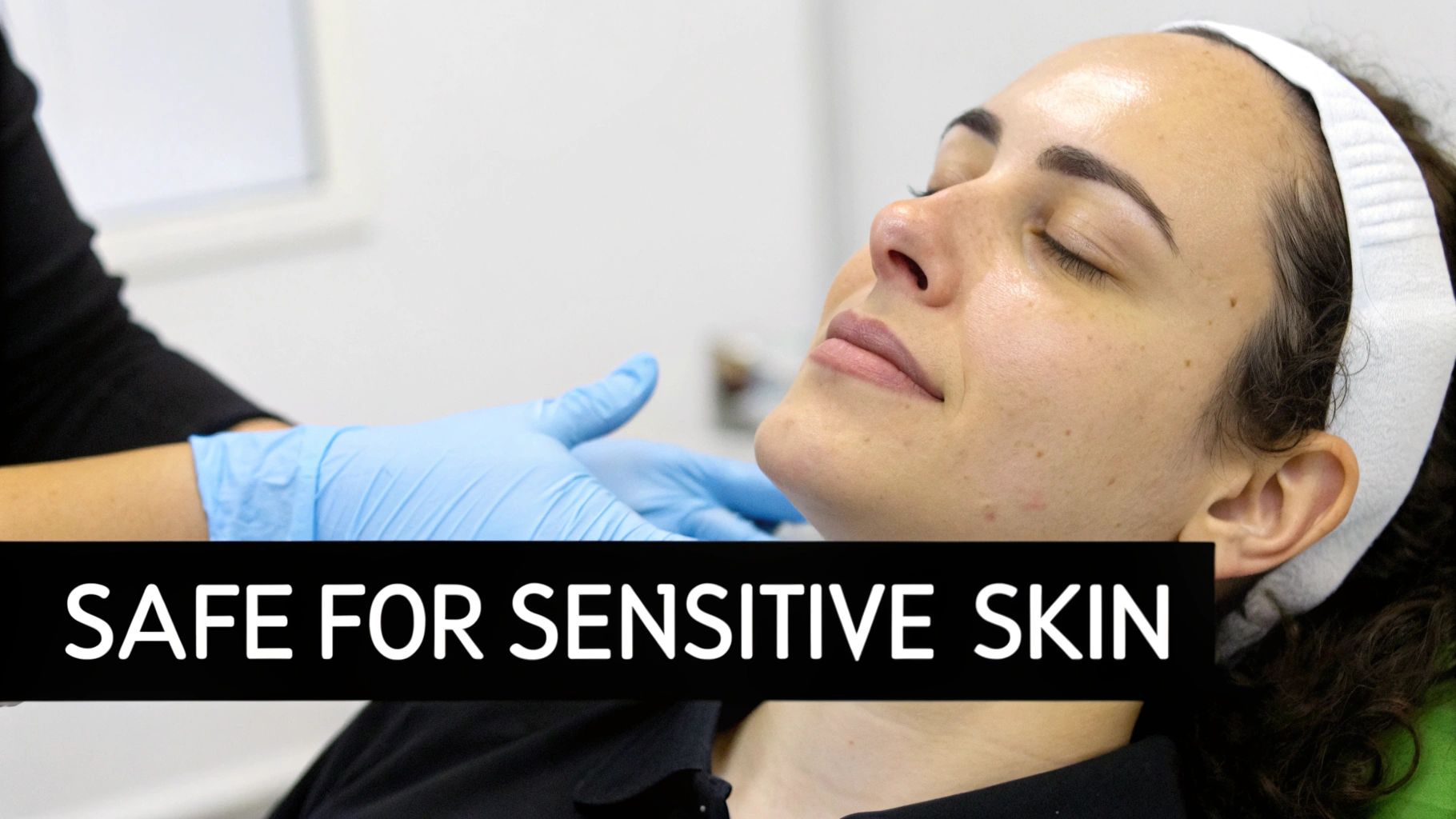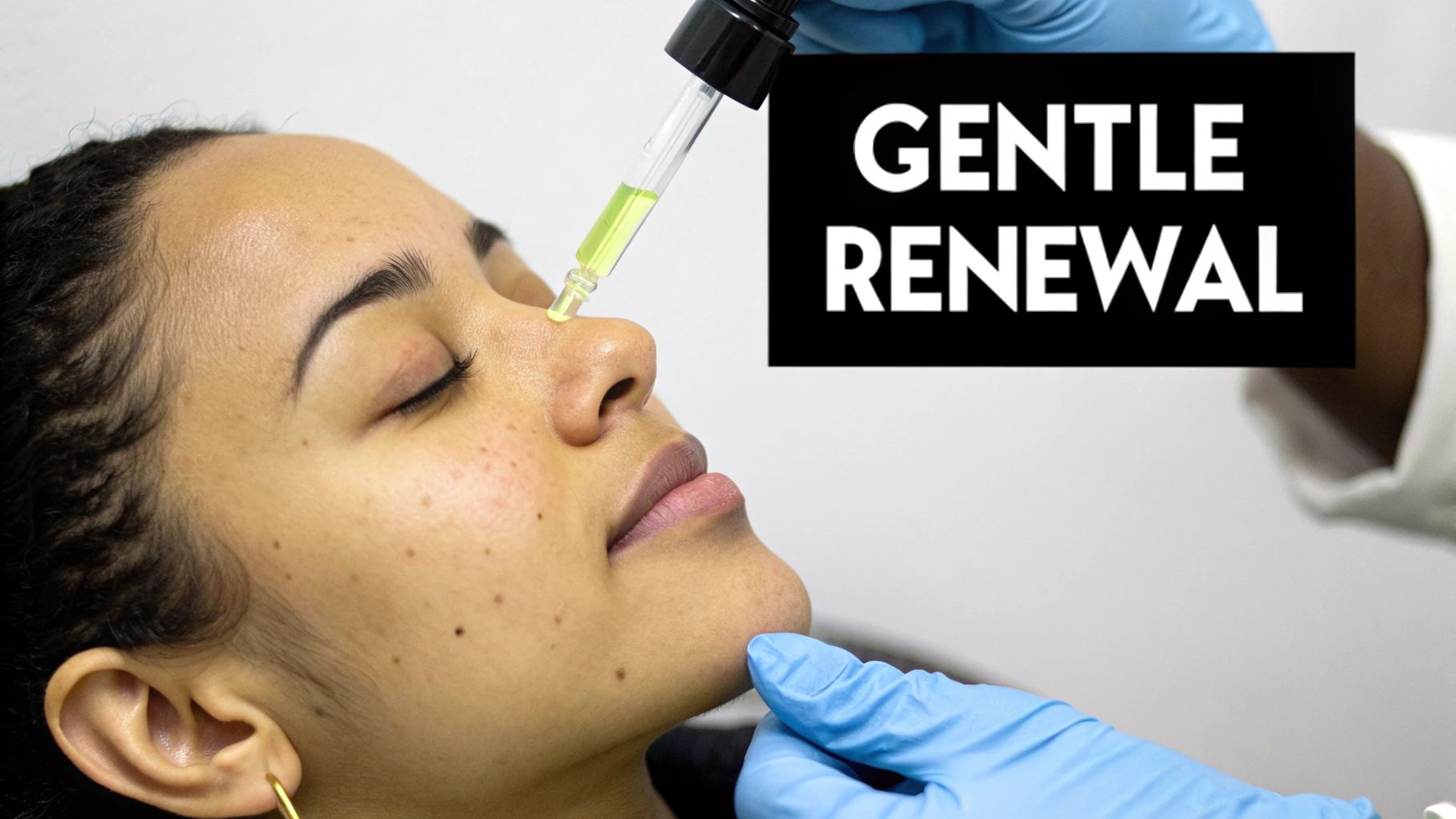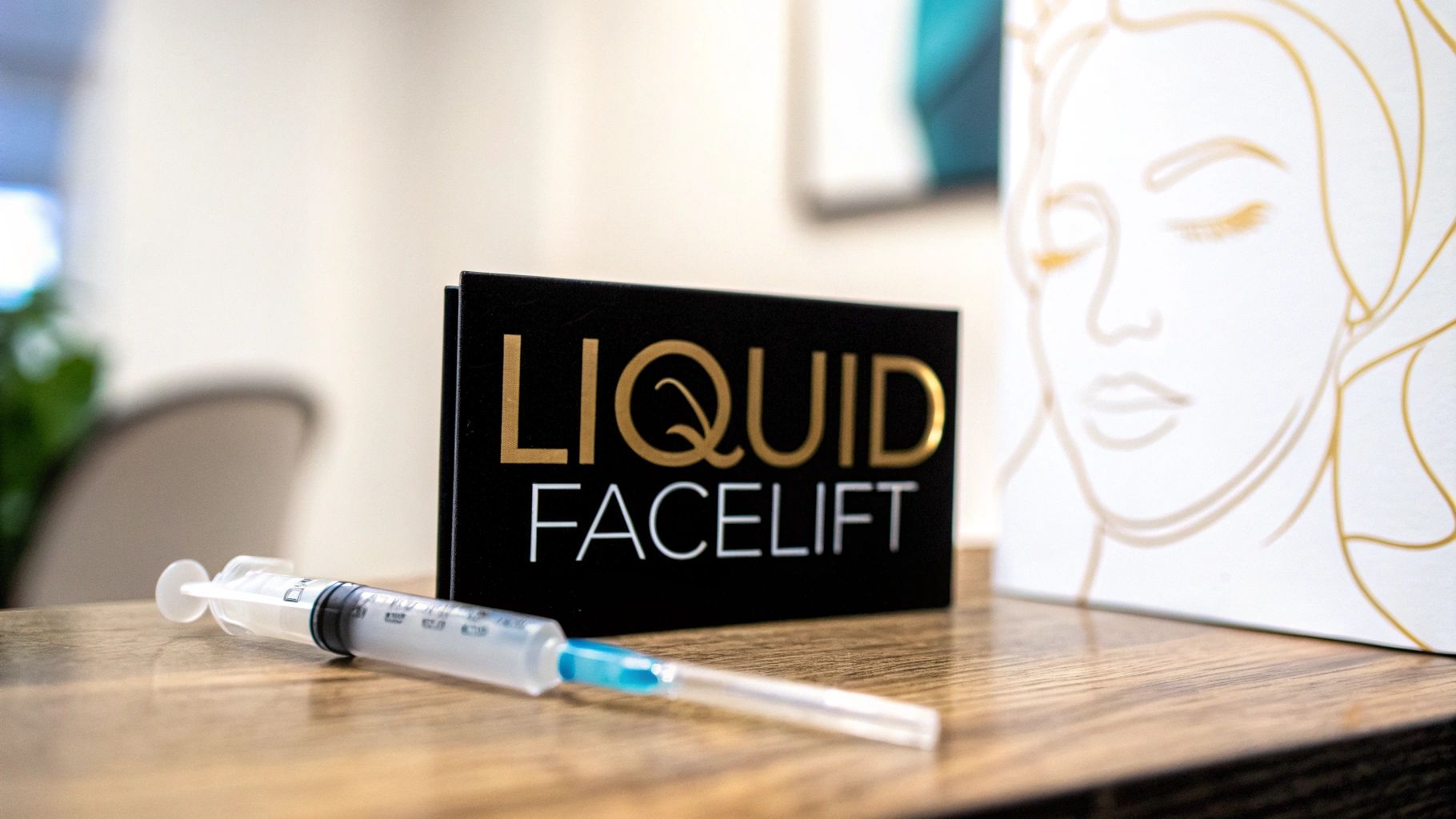
December 21, 2025
Discover best procedures for aging skin today
Explore best procedures for aging skin - from non-invasive treatments to surgical options - and see downtime, costs, and results.
Nov 6, 2025

The short answer? Yes, you absolutely can. Long gone are the days of one-size-fits-all, aggressive peels. Today's formulas are far more sophisticated, meaning there are fantastic options designed specifically for chemical peels for sensitive skin. The key is working with a seasoned professional who knows how to choose the right gentle formula to bring out your skin's best without triggering irritation.
Think of it less as a harsh "peel" and more like carefully polishing a delicate piece of jewelry to reveal its natural brilliance.

If the words "chemical peel" conjure images of red, raw skin, you're not alone. The name itself can be intimidating, especially if you already deal with reactivity or easy irritation. But the reality of modern skincare is much more refined. A peel for sensitive skin isn't about aggressively stripping away layers; it's a controlled, superficial exfoliation that tackles skin concerns with finesse.
This gentler approach is a big reason why the treatment has become so popular. The global chemical peel market, valued at around USD 2.02 billion, is on a steady growth track. This boom is fueled by people just like you, who want real results from treatments that cater to their specific skin needs, sensitivity included.
It all comes down to the science—specifically, the type and concentration of the acids used in the peel solution.
Deeper, more intense peels use aggressive agents that penetrate far into the skin. Gentle peels, on the other hand, rely on acids with larger molecules, like lactic acid or mandelic acid. Because these molecules are bigger, they can't sink into the skin as deeply or as quickly. This simple fact dramatically cuts down the risk of irritation, making the whole experience much more comfortable.
This controlled, surface-level approach delivers some beautiful benefits:
The goal isn't to force a dramatic, flaky peel. It's to support your skin's own natural renewal cycle. A great peel for sensitive skin leaves you looking refreshed and glowing, not red and angry. It’s all about the partnership between an expert esthetician and the right formula.
Navigating the world of acids can be tricky. This table provides a quick reference to help you understand which peels are your allies and which ones are generally best to avoid if your skin is reactive.
This is just a starting point, of course. A consultation with a professional is the best way to determine the perfect plan for your unique skin.
To get the best results, it helps to walk into your appointment feeling prepared. Understanding the different types of chemical peels and who they are for is a fantastic first step. This guide will cover everything else you need to know, from the best peel types for you to what to expect during and after your treatment.

Putting "acid" and "sensitive skin" in the same sentence sounds like a recipe for disaster. I get it. But the magic of a gentle chemical peel for sensitive skin is all in the science of its delivery.
Imagine a smart exfoliation system that’s programmed to only target the dull, lifeless cells sitting on the very top layer of your skin. It leaves the healthy, happy skin underneath completely untouched. This isn’t a harsh stripping process; it's a precise, targeted refresh.
The secret? It comes down to the size of the molecules in the acids we use. Gentle peels typically feature alpha-hydroxy acids (AHAs) like Lactic Acid and Mandelic Acid. These guys have a much larger molecular structure compared to more aggressive acids, like glycolic acid.
This larger size is the game-changer. It physically prevents the acid from diving too deep, too fast. Instead, it works slowly and methodically right at the surface, giving us controlled exfoliation without sending your skin's alarm bells ringing.
So, what’s actually happening on a microscopic level? These larger AHA molecules gently dissolve the bonds—think of it like a weak glue—holding those dead skin cells together. This kicks off a chain reaction of positive effects, all without triggering the inflammation that sensitive skin dreads.
This process sends a polite nudge to your skin to speed up its natural cell turnover cycle. In other words, it encourages fresh, plump new cells to make their way to the surface a little quicker than usual.
The end result is a complexion that looks brighter and feels smoother, not because it's been aggressively resurfaced, but because its own renewal process has been expertly supported.
A gentle chemical peel works with your skin, not against it. By carefully lifting away the surface barrier of old cells, it paves the way for better product absorption, boosts hydration, and lets your healthier skin shine through.
The real beauty of this approach is getting those visible, glowy results while completely respecting the boundaries of your sensitive skin. The renewal is gradual and supportive, leading to improvements that build with each treatment.
Here’s a breakdown of what this gentle stimulation can do for you:
This careful, intelligent approach ensures that even the most reactive skin can finally enjoy the benefits of professional exfoliation. And for those who want to go even deeper, understanding how our internal health impacts our skin is crucial. You can explore the link between diet and skin vitality by reading about the fascinating gut-skin axis.
Ultimately, the goal isn't to force aggressive peeling. It’s about achieving a healthy, lasting glow. This is a sophisticated treatment designed to revitalize your skin and strengthen it over the long haul, proving that you don't always need an aggressive approach to get powerful results.
Now that you know what a gentle chemical peel for sensitive skin is all about, let’s get into the fun part: choosing the right one for you. Think of these peels not as a one-size-fits-all solution, but as a team of specialists. Each one has a particular talent for tackling different skin concerns.
The goal isn't to pick the "strongest" one you think your skin can handle. Instead, it’s about getting clear on what you want to achieve. Are you looking to quench thirsty skin, fade stubborn dark spots, or just get that healthy, lit-from-within glow? Matching your goal to the right peel is the secret to getting results you'll love.
If your sensitive skin often feels tight, looks dull, or is chronically dry, lactic acid is your new best friend. This alpha-hydroxy acid (AHA) comes from milk and is famous for being incredibly gentle. Because its molecules are on the larger side, it works right at the surface of your skin, which dramatically cuts down the risk of irritation.
But here’s its real claim to fame: lactic acid is a humectant. That means while it’s busy sloughing off dead skin, it’s also pulling moisture into your skin.
Are you dealing with those pesky dark spots that acne leaves behind? Or maybe some mild sun damage? If so, mandelic acid is the perfect choice for sensitive skin. It’s derived from bitter almonds and has an even larger molecular structure than lactic acid, making it one of the gentlest AHAs out there.
This slow-and-steady approach makes it a fantastic option for deeper skin tones, which can sometimes be more prone to pigmentation issues after treatments. It carefully lifts away discolored cells from the surface, promoting a more even, uniform complexion over time. As a bonus, it has natural antibacterial properties, making it great for reactive skin that's also prone to breakouts.
Think of Mandelic Acid as a careful artist, delicately fading away unwanted spots and discoloration without disturbing the surrounding canvas. It’s the ideal choice for achieving clarity and brightness without risking irritation.
If your skin is incredibly reactive or if you're just dipping your toes into the world of peels, an enzyme peel is the perfect place to start. These peels don't use acids at all. Instead, they harness the power of natural fruit enzymes—like bromelain from pineapple or papain from papaya—to gently dissolve dead skin cells.
The action is extremely superficial, making them one of the safest options available.
The skincare world has certainly taken notice of these milder options. Industry data reveals that superficial peels are overwhelmingly the top choice for sensitive skin, thanks to their great results and minimal recovery time. In fact, the fruit peel market—which includes gentle AHAs like lactic acid—commands a massive 24.5% of the global market share, making it the leading category. Both professionals and at-home users love these organic acid peels because they deliver a beautiful outcome without the risks of more aggressive treatments.
While options like a Glycolic Peel treatment exist, it's vital to ensure it's a very low concentration specifically formulated for sensitive skin. And remember, peels aren't just for your face. If you're weighing your options, you might find it helpful to see how they compare to other popular procedures in our guide on microneedling vs. chemical peels. This can help you decide which treatment path aligns best with your ultimate skin goals.
To make the choice even clearer, here’s a detailed comparison to help you choose the best gentle peel based on your specific skincare concerns and goals.
Ultimately, this table helps narrow down the choices, but the best first step is always a conversation with a trusted skincare professional who can assess your skin in person and guide you toward the perfect peel.
Knowing what to expect can take all the guesswork and anxiety out of the process, turning it into something you can actually look forward to. A great chemical peel for sensitive skin is really a team effort between you and your practitioner. The journey starts well before you even walk through the clinic door.
Let's break down the whole experience into three distinct phases: getting your skin ready, the treatment itself, and the all-important recovery period.
Proper prep work is the secret sauce for a comfortable peel and stunning results. Think of it like priming a canvas before painting a masterpiece; you're setting the stage for the peel to do its best work, safely and effectively.
About a week before your appointment, you’ll need to make a few temporary tweaks to your skincare routine. Your provider will give you a specific game plan, but it almost always involves hitting pause on certain active ingredients to keep your skin from getting overstimulated.
Your pre-peel checklist will probably look something like this:
This infographic gives you a great visual breakdown of the gentle options you and your aesthetician might talk about during your consultation.

As you can see, each one is tailored for different goals—from boosting hydration to evening out skin tone—which is what makes a personalized treatment so powerful.
When peel day arrives, just come in with a clean, makeup-free face. The whole process is surprisingly quick, usually wrapping up in about 30 minutes.
First, your aesthetician will give your skin a thorough cleanse to get rid of any lingering oils or dirt. Then, they’ll apply the chemical solution, typically using a soft brush or cotton pad. This is when you'll start to feel it working.
Most people describe the sensation as a light tingle, a bit of itchiness, or a gentle warmth. It should feel active, but it definitely shouldn't hurt. Your practitioner will be watching you like a hawk and can neutralize the peel instantly if you feel any real discomfort.
After the solution has been on for just the right amount of time, it's neutralized and wiped away. To finish, your practitioner will apply a soothing serum and, most critically, a broad-spectrum sunscreen to shield your fresh, new skin.
How you care for your skin after the peel is just as crucial as the treatment itself. For the next 5-7 days, your skin is in a delicate healing mode. Your only job is to be incredibly gentle with it.
Your aftercare routine should be stripped back to the basics, focusing on three things: gentle cleansing, consistent hydration, and sun protection.
1. Cleanse with Care: Stick to a mild, soap-free cleanser and lukewarm water. When you're done, gently pat your skin dry with a soft towel—no rubbing!
2. Hydrate and Soothe: Slather on a simple, fragrance-free moisturizer. This helps keep your skin hydrated and supports its healing barrier. Steer clear of any products with active ingredients until your provider says it's okay.
3. Protect with SPF: Sunscreen is your new best friend. Your skin is extremely vulnerable to UV damage right now, which can easily lead to unwanted pigmentation. Apply a broad-spectrum SPF 30 or higher every single day, no excuses, even if you’re just staying inside.
This focus on gentle, supportive care is a huge part of modern dermatology. The chemical peel market has shifted significantly toward safer, more adaptable treatments that cater to sensitive skin. In fact, the global market value has grown from around USD 1.5 billion to over USD 2 billion, with superficial peels leading the charge because they're non-invasive and perfect for reactive complexions.
For a deeper dive into aftercare for a specific type of peel, our guide on TCA peel post-care has some fantastic tips that are helpful for many different treatments.
Let’s be honest: the words “chemical” and “peel” can sound a little intimidating, especially when you have sensitive skin. While the peels we’re talking about are incredibly gentle and have a fantastic safety profile, it’s smart to know what to expect. Being well-informed is the best way to feel confident and ensure everything goes smoothly.
Most side effects are very minor and don't last long. You might see some temporary redness, feel a bit of tightness, or notice your skin is slightly more sensitive than usual—think of it like a very mild sunburn. This usually fades within a few hours to a day. The whole point is to gently nudge your skin toward renewal, not to shock it into submission.
I can't stress this enough: the single most important factor in a safe and successful peel is the person performing it. Don't bargain shop for this. Seeing a board-certified dermatologist or a licensed esthetician with deep experience in treating sensitive skin is non-negotiable.
A true expert does more than just slather a solution on your face. They:
Think of the relationship with your practitioner as a partnership. Their expertise is one half of the equation; the other is your honest feedback and commitment to following their guidance. This teamwork is what turns a potential risk into a preventable non-issue.
What you do before and after your appointment is just as crucial as the peel itself. Following your practitioner’s aftercare instructions to the letter is the best thing you can do to guarantee a smooth, complication-free recovery. You're protecting your investment in your skin.
Good post-peel care is simple but non-negotiable. It means staying out of the sun and wearing a broad-spectrum sunscreen of SPF 30 or higher every single day, no exceptions. Your new, delicate skin is highly vulnerable to UV rays, which can cause the very pigmentation issues you’re trying to correct.
You also have to fight the urge to pick or scrub at any flaking skin. Let it shed on its own schedule. Pulling it off before it's ready can lead to irritation, scarring, or even an infection. By following these simple rules, you become an active partner in your skin's healing, setting the stage for that beautiful, glowing outcome you’re after.
https://www.youtube.com/embed/30jxa124TwU
Stepping into the world of chemical peels can feel a little intimidating, especially with sensitive skin. It’s only natural to have questions. Here are some straightforward answers to the things we get asked most often.
For a gentle chemical peel for sensitive skin, the sweet spot is usually every 4-6 weeks. This timing isn't random; it perfectly aligns with your skin's natural renewal cycle, giving it plenty of time to heal and regenerate between treatments.
Think of it less as a constant attack and more as a helpful nudge in the right direction. Sticking to this schedule prevents the dreaded over-exfoliation that can damage your skin's protective barrier. Your esthetician or dermatologist will help you zero in on the perfect timing based on how your skin handles the first session.
This is a really important question, and the answer requires a bit of nuance. First, a chemical peel should never be performed during an active rosacea or eczema flare-up. When your skin barrier is already compromised, the peel will only add fuel to the fire and increase inflammation.
That said, for those with rosacea that is well-managed, certain very gentle peels can actually be a game-changer. Acids like mandelic and azelaic are known for their anti-inflammatory properties and can help calm redness and smooth out texture. This is a treatment that absolutely must be done under the supervision of a dermatologist who can confirm it's a safe choice for your specific situation.
Crucial Takeaway: When you're dealing with a pre-existing condition like rosacea or eczema, getting a green light from a medical professional isn't just a suggestion—it's non-negotiable for keeping your skin safe and healthy.
The biggest distinctions between doing a peel at home versus getting one in a clinic come down to three things: acid strength, pH level, and expert oversight. At-home peels are designed for mass-market safety, so they contain much lower acid concentrations and have a higher pH, making them far less potent.
Professional peels, on the other hand, are formulated with medical-grade ingredients at a much lower pH. This is what allows them to work more deeply and deliver more dramatic, predictable results. A trained expert is also right there to customize the formula, apply it correctly, and watch your skin's reaction second-by-second.
A good way to think about it is this: at-home peels are like light maintenance, perfect for brightening your complexion between appointments. A professional peel is the main event, a targeted treatment that provides a significant reset in a controlled, safe environment.
At Cape Cod Plastic Surgery, we specialize in creating personalized skincare plans that respect the unique needs of your sensitive skin. If you're ready to explore how a professionally administered chemical peel can safely reveal your most radiant complexion, we invite you to schedule a consultation. Let our experts guide you on your journey to healthy, beautiful skin. Find out more at https://ccplasticsurgery.com.

December 21, 2025
Explore best procedures for aging skin - from non-invasive treatments to surgical options - and see downtime, costs, and results.

December 20, 2025
What is a liquid facelift? Learn how dermal fillers and neuromodulators restore youthful contours without surgery, with benefits, costs, and expected results.

December 19, 2025
Wondering how long before botox kicks in? Discover a day-by-day timeline, key factors, and when you will see the full effect.